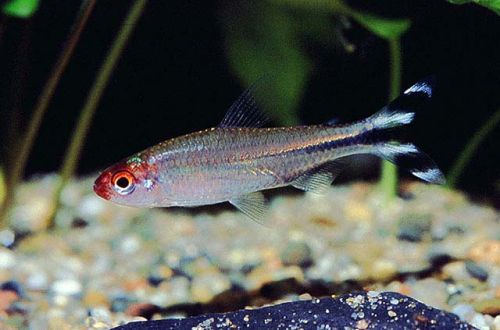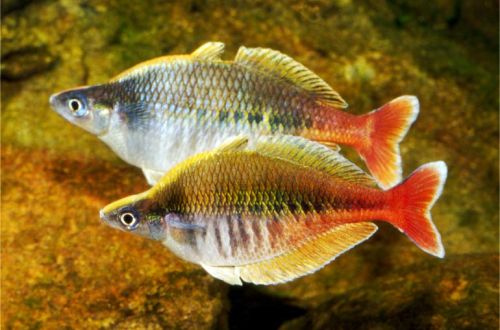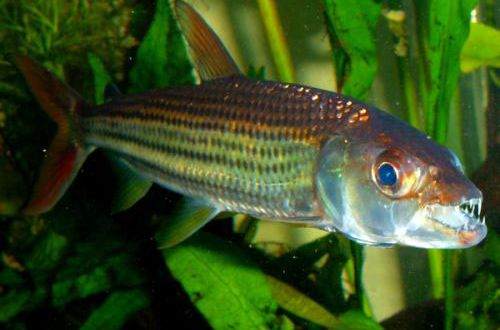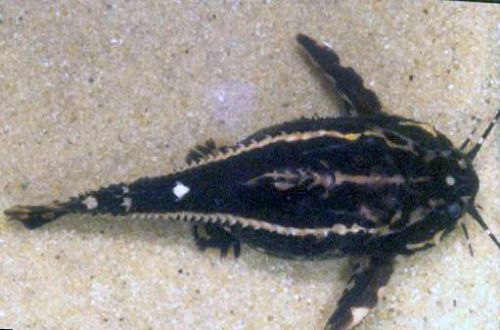
False Rhodostomus
False Red-nosed Tetra or False Rhodostomus, scientific name Petitella georgiae, belongs to the Characidae family. As the name implies, this fish is very similar to the two closely related species Red-nosed Tetra and Rhodostomus, respectively. The differences are so small that even experienced aquarists can easily make mistakes.

Contents
Description
The fish reaches a length of about 5 cm. The color of the body is gray or silver, the head is red. At the same time, the red pigment does not go beyond the gill covers, as in the Red-nosed Tetra, and is less intense than in Rhodostomus.
Another distinguishing feature can be noted in the characteristic black and white pattern of the caudal fin found in these three species. In False Rhodostomus, the central black stroke does not end at the tail, but continues further along the caudal peduncle.
Brief information:
- The volume of the aquarium – from 70 liters.
- Temperature – 24-28°C
- Value pH — 5.0–7.0
- Water hardness – soft (1-12 dGH)
- Substrate type – any sandy
- Lighting – subdued
- Brackish water – no
- Water movement is weak
- The size of the fish is up to 5 cm.
- Food – any food
- Temperament – peaceful
- Keeping in a flock of at least 6-10 individuals
Habitat
Native to South America. It occurs naturally in the basin of large tributaries of the Amazon River, such as the Purus, Rio Negro and Madeira in Peru and Brazil. Inhabits small streams and rivers flowing under the dense canopy of the tropical forest. The bottom is usually covered with a layer of fallen leaves, branches, and various snags. The water is dark in color due to the high concentration of tannins formed as a result of the decomposition of plant organic matter.
Maintenance and care, arrangement of the aquarium
The optimal size of an aquarium for a flock of 6-10 fish starts at 70 liters. In the design, it is recommended to use a dark substrate on which to place several natural snags. Aquatic plants are optional, but a few surface-floating species can be used for shading. The lighting is subdued.
A good choice would be the leaves and bark of some trees, which in the process of decomposition will saturate the water with tannins, as happens in nature, and give it a tea shade. Read more in the article “Which tree leaves can be used in an aquarium.”
The fish need clean water, do not tolerate the accumulation of organic waste (food leftovers, excrement) and need very soft (dKH) acidic water.
Food
They accept almost all types of food of a suitable size in dry, frozen and live form.
Behavior and Compatibility
False Red-nosed Tetra is peaceful, prefers to be in the company of relatives, so it is worth buying in flocks of 6 individuals. Compatible with other calm fish of comparable size, such as apistograms and other small South American cichlids, corydoras catfish, tetras, as well as small barbs, rasboras and others.
Breeding / breeding
With the right conditions and a protein-rich diet, the chances that the fish will spawn are very high. With the onset of the breeding season, the females either scatter the eggs along the bottom, or throw their eggs among small-leaved plants, mosses or ferns, if any.
Parental instincts are not developed, so there is no concern for future offspring. Fish tend to eat their eggs and fry. If breeding is planned, then spawning is preferably carried out in a separate tank, where males and females are placed in advance. The latter can be distinguished by their noticeably enlarged bellies.
Fry emerge from eggs within 24-36 hours. After another 3-4 days, they begin to swim freely. From this point on, special foods can be fed in the form of powders, suspensions, or, if possible, live foods such as Artemia nauplii.
Fish diseases
The main threat to the health of fish is poor living conditions. The cause of the disease can also be contact with a new infected fish, injury, poor nutrition. If the first symptoms are found, first of all it is necessary to check what environment the fish are in and, if there are problems, fix them. If the condition persists or worsens, medical treatment will be required. Read more in the section “Diseases of aquarium fish”.





